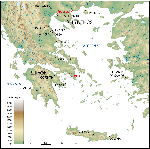Promised is an EU funded coordination and support project with emphasis placed on the joint cooperation of the members of the consortium. Despite the fact that the project does not fund directly research activity, numerous high-impact publications are expected to come out of the enhanced synergies between the partners.
A constantly updated list of the exciting project related publications can be found here.
Digital Zooarchaeology: State of the art, challenges, prospects and synergies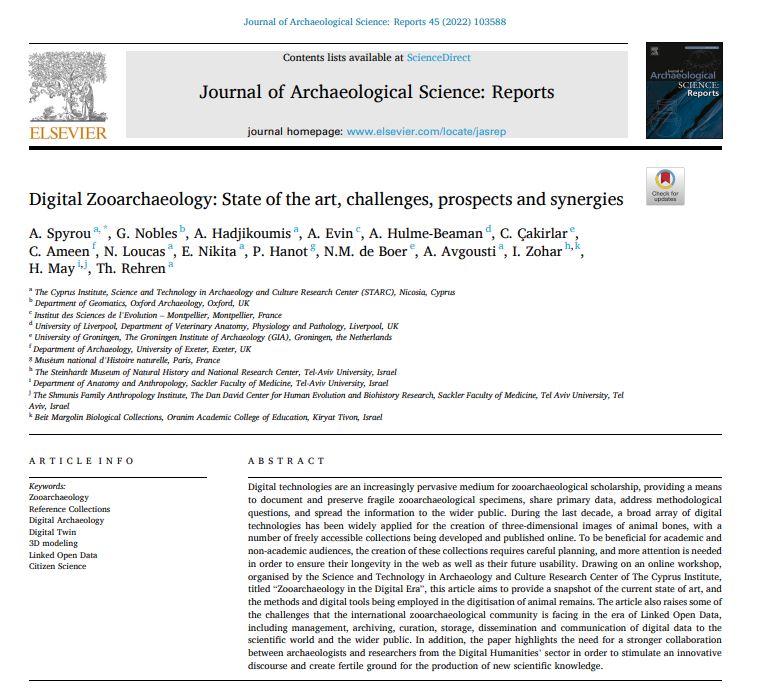
|
Spyrou et al. 2022 Digital technologies are an increasingly pervasive medium for zooarchaeological scholarship, providing a means to document and preserve fragile zooarchaeological specimens, share primary data, address methodological questions, and spread the information to the wider public. During the last decade, a broad array of digital technologies has been widely applied for the creation of three-dimensional images of animal bones, with a number of freely accessible collections being developed and published online. To be beneficial for academic and non-academic audiences, the creation of these collections requires careful planning, and more attention is needed in order to ensure their longevity in the web as well as their future usability. Drawing on an online workshop, organised by the Science and Technology in Archaeology and Culture Research Center of The Cyprus Institute, titled “Zooarchaeology in the Digital Era”, this article aims to provide a snapshot of the current state of art, and the methods and digital tools being employed in the digitisation of animal remains. The article also raises some of the challenges that the international zooarchaeological community is facing in the era of Linked Open Data, including management, archiving, curation, storage, dissemination and communication of digital data to the scientific world and the wider public. In addition, the paper highlights the need for a stronger collaboration between archaeologists and researchers from the Digital Humanities’ sector in order to stimulate an innovative discourse and create fertile ground for the production of new scientific knowledge. |
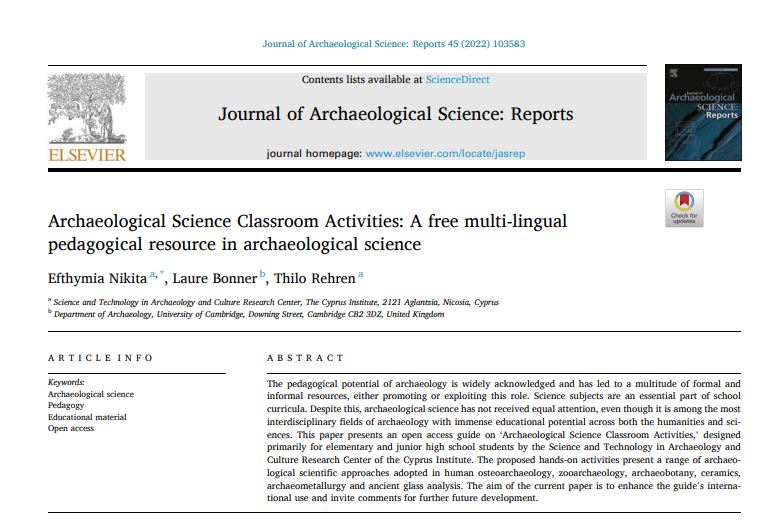 |
|
The pedagogical potential of archaeology is widely acknowledged and has led to a multitude of formal and informal resources, either promoting or exploiting this role. Science subjects are an essential part of school curricula. Despite this, archaeological science has not received equal attention, even though it is among the most interdisciplinary fields of archaeology with immense educational potential across both the humanities and sciences. This paper presents an open access guide on ‘Archaeological Science Classroom Activities,’ designed primarily for elementary and junior high school students by the Science and Technology in Archaeology and Culture Research Center of the Cyprus Institute. The proposed hands-on activities present a range of archaeological scientific approaches adopted in human osteoarchaeology, zooarchaeology, archaeobotany, ceramics, archaeometallurgy and ancient glass analysis. The aim of the current paper is to enhance the guide’s international use and invite comments for further future development. |
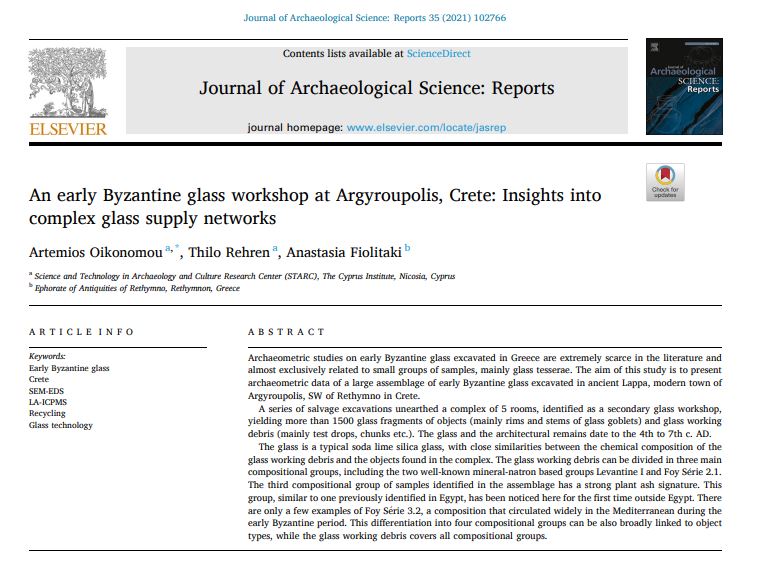 Oikonomou et al. 2021
Oikonomou et al. 2021
Archaeometric studies on early Byzantine glass excavated in Greece are extremely scarce in the literature and almost exclusively related to small groups of samples, mainly glass tesserae. The aim of this study is to present archaeometric data of a large assemblage of early Byzantine glass excavated in ancient Lappa, modern town of Argyroupolis, SW of Rethymno in Crete.A series of salvage excavations unearthed a complex of 5 rooms, identified as a secondary glass workshop, yielding more than 1500 glass fragments of objects (mainly rims and stems of glass goblets) and glass working debris (mainly test drops, chunks etc.). The glass and the architectural remains date to the 4th to 7th c. AD.The glass is a typical soda lime silica glass, with close similarities between the chemical composition of the glass working debris and the objects found in the complex. The glass working debris can be divided in three main compositional groups, including the two well-known mineral-natron based groups Levantine I and Foy Série 2.1. The third compositional group of samples identified in the assemblage has a strong plant ash signature. This group, similar to one previously identified in Egypt, has been noticed here for the first time outside Egypt. There are only a few examples of Foy Série 3.2, a composition that circulated widely in the Mediterranean during the early Byzantine period. This differentiation into four compositional groups can be also broadly linked to object types, while the glass working debris covers all compositional groups.
Egyptian Middle Kingdom copper: Analysis of a crucible from Buhen in the Petrie Museum
Christopher Davey, Thilo Rehren and Brunella Santarelli
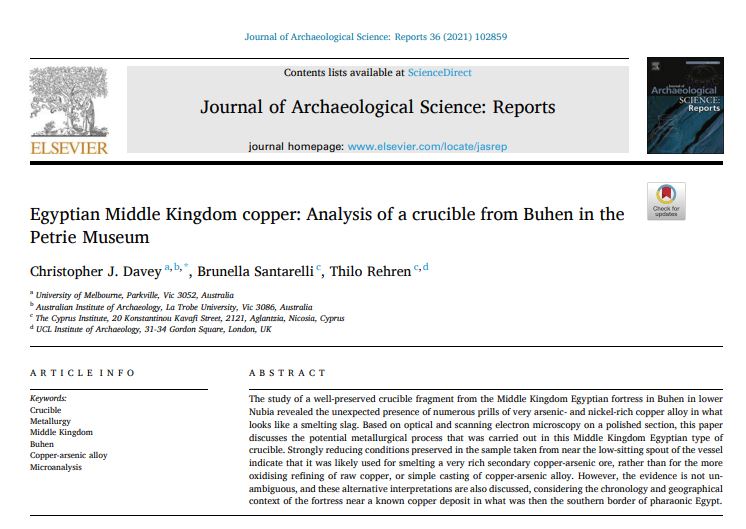 The study of a well-preserved crucible fragment from the Middle Kingdom Egyptian fortress in Buhen in lower Nubia revealed the unexpected presence of numerous prills of very arsenic- and nickel-rich copper alloy in what looks like a smelting slag. Based on optical and scanning electron microscopy on a polished section, this paper discusses the potential metallurgical process that was carried out in this Middle Kingdom Egyptian type of crucible. Strongly reducing conditions preserved in the sample taken from near the low-sitting spout of the vessel indicate that it was likely used for smelting a very rich secondary copper-arsenic ore, rather than for the more oxidising refining of raw copper, or simple casting of copper-arsenic alloy. However, the evidence is not unambiguous, and these alternative interpretations are also discussed, considering the chronology and geographical context of the fortress near a known copper deposit in what was then the southern border of pharaonic Egypt.
The study of a well-preserved crucible fragment from the Middle Kingdom Egyptian fortress in Buhen in lower Nubia revealed the unexpected presence of numerous prills of very arsenic- and nickel-rich copper alloy in what looks like a smelting slag. Based on optical and scanning electron microscopy on a polished section, this paper discusses the potential metallurgical process that was carried out in this Middle Kingdom Egyptian type of crucible. Strongly reducing conditions preserved in the sample taken from near the low-sitting spout of the vessel indicate that it was likely used for smelting a very rich secondary copper-arsenic ore, rather than for the more oxidising refining of raw copper, or simple casting of copper-arsenic alloy. However, the evidence is not unambiguous, and these alternative interpretations are also discussed, considering the chronology and geographical context of the fortress near a known copper deposit in what was then the southern border of pharaonic Egypt.
Efthymia Nikita & Panos Nikitas (2022)
This paper extends the Suzuki and Shimodora method [Suzuki R, Shimodora H. Pvclust: an R package for assessing the uncertainty in hierarchical clustering. Bioinformatics. 2006;22:1540–1542] for assessing uncertainty in hierarchical cluster analysis to multivariate datasets and examines the reliability of the simulated cluster probabilities in relation to the simulation method adopted. The extension is applied to squared Euclidean and Mahalanobis-type distances and employs three simulation methods, the Monte-Carlo and bootstrap methods, and a new proposed method, the distance distribution. The distance distribution method is very fast and gives satisfactory predictions for the distance, its standard deviation, skewness, and kurtosis. The performance of the Monte-Carlo method is equally satisfactory, whereas the bootstrap method usually gives acceptable predictions only for the distance. The distance distribution and Monte-Carlo methods give similar cluster probabilities. The bootstrap probabilities are not very different; thus this method can be used in datasets of unknown distance distribution.
Read more at Taylor and Francis Online
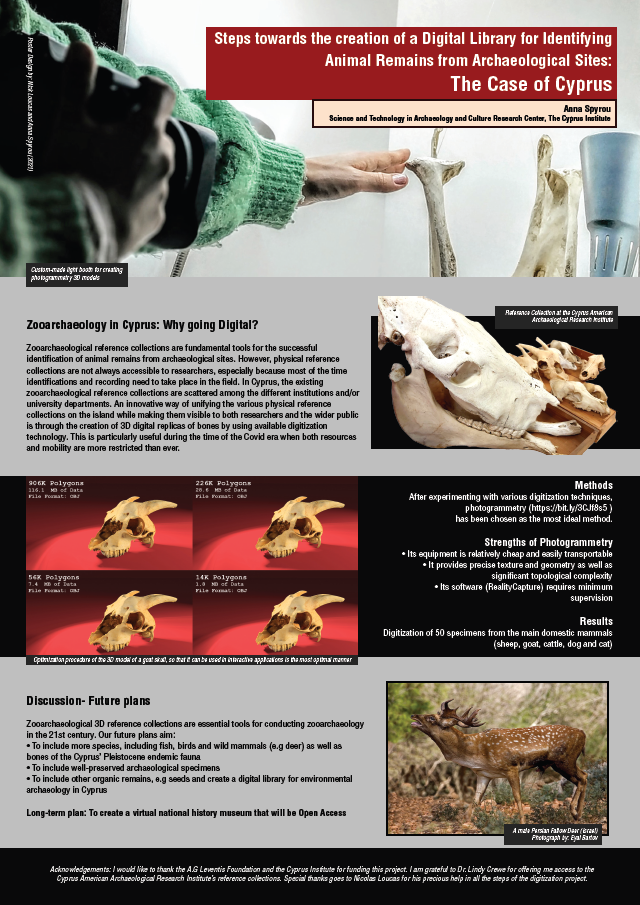 Steps towards the creation of a Digital Library for Identifying Animal Remains from Archaeological Sites: The Case of Cyprus
Steps towards the creation of a Digital Library for Identifying Animal Remains from Archaeological Sites: The Case of Cyprus
As part of Promised, we are exploring the potential for 3D-based reference collections in archaeozoology. Dr Spyrou assembled an international team of colleagues for an online workshop in December 2020 to exchange ideas and share experiences; the results of this workshop were written up as a review paper which is currently under consideration with an international journal. In parallel, Dr Spyrou developed a workflow within STARC to test different methods of 3D documentation; the results of this she presented at the ASOR conference in Chicago as a poster. [The word poster could then have the download link for the actual poster file, attached] In spring 2022, Dr Spyrou will spend two months at the MacDonald Institute of the University of Cambridge to be trained in the application of paleoproteomics to archaeozoology, before starting a 2-year postdoctoral project an ancient cattle domestication at the Cyprus Institute later this year.
Read more here
Efthymia Nikita, Mahmoud Mardini, Mohamad Mardini, Chrysoula Tsimopoulou, Anna Karligkioti (2021)
The current paper presents Bi(bli)oArch, a free online bibliographic database for human bioarchaeology in the Eastern Mediterranean and Middle East (EMME); a geographic region at the crossroads of three continents and a melting pot of diverse civilizations throughout human evolution. The aim of Bi(bli)oArch is to promote human bioarchaeological studies in the region and facilitate meta-analyses by making the titles of available studies more easily findable by international scholars. At the moment, many publications are difficult to identify, as they appear in national languages of the region and/or in outputs such as national conference proceedings, graduate theses, and monograph appendices. This paper presents the main functionalities of Bi(bli)oArch, briefly outlines some key trends in EMME bioarchaeology as revealed through the 3,521 papers that are currently included in this database, and invites scholars working in the EMME to contribute to this initiative so that Bi(bli)oArch develops into a standard bibliographic bioarchaeological resource for the region.
Read more at SCIENCE DIRECT
Carolyne Douché, Kyriaki Tsirtsi, Evi Margaritis (2021)
This paper investigates agricultural practices during the 1st millennium BCE in Greece. New archaeobotanical data provide fresh insights on the plant economy at the urban centers of Sikyon and Olynthos, dated to the Archaic-Classical period. The results show that the staple economy of Sikyon and Olynthos was based on a broad spectrum. However, the analysis records the presence of taxa such as sesame (Sesamum indicum) and pine (Pinus pinea) that are usually absent in assemblages from Greece. In order to understand the role and the place of these sites within the ancient Greek world, we draw a wider comparison of the ubiquity of the main economic taxa using available archaeobotanical records, covering the Protogeometric period to the end of the Hellenistic period. This paper gives an overview of plants exploited during the 1st millennium BCE and also focuses on the unusual remains recently recovered.
Read more at SCIENCE DIRECT
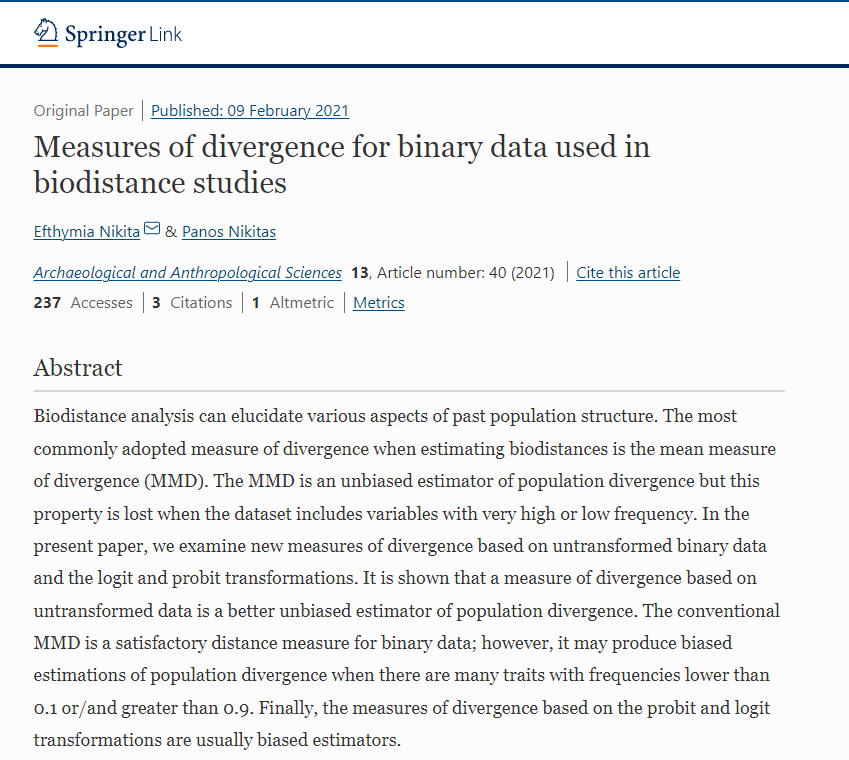 Measures of divergence for binary data used in biodistance studies
Measures of divergence for binary data used in biodistance studies
Efthymia Nikita & Panos Nikitas (2021)
Biodistance analysis can elucidate various aspects of past population structure. The most commonly adopted measure of divergence when estimating biodistances is the mean measure of divergence (MMD). The MMD is an unbiased estimator of population divergence but this property is lost when the dataset includes variables with very high or low frequency. In the present paper, we examine new measures of divergence based on untransformed binary data and the logit and probit transformations. It is shown that a measure of divergence based on untransformed data is a better unbiased estimator of population divergence. The conventional MMD is a satisfactory distance measure for binary data; however, it may produce biased estimations of population divergence when there are many traits with frequencies lower than 0.1 or/and greater than 0.9. Finally, the measures of divergence based on the probit and logit transformations are usually biased estimators.
Read more at SpringerLink
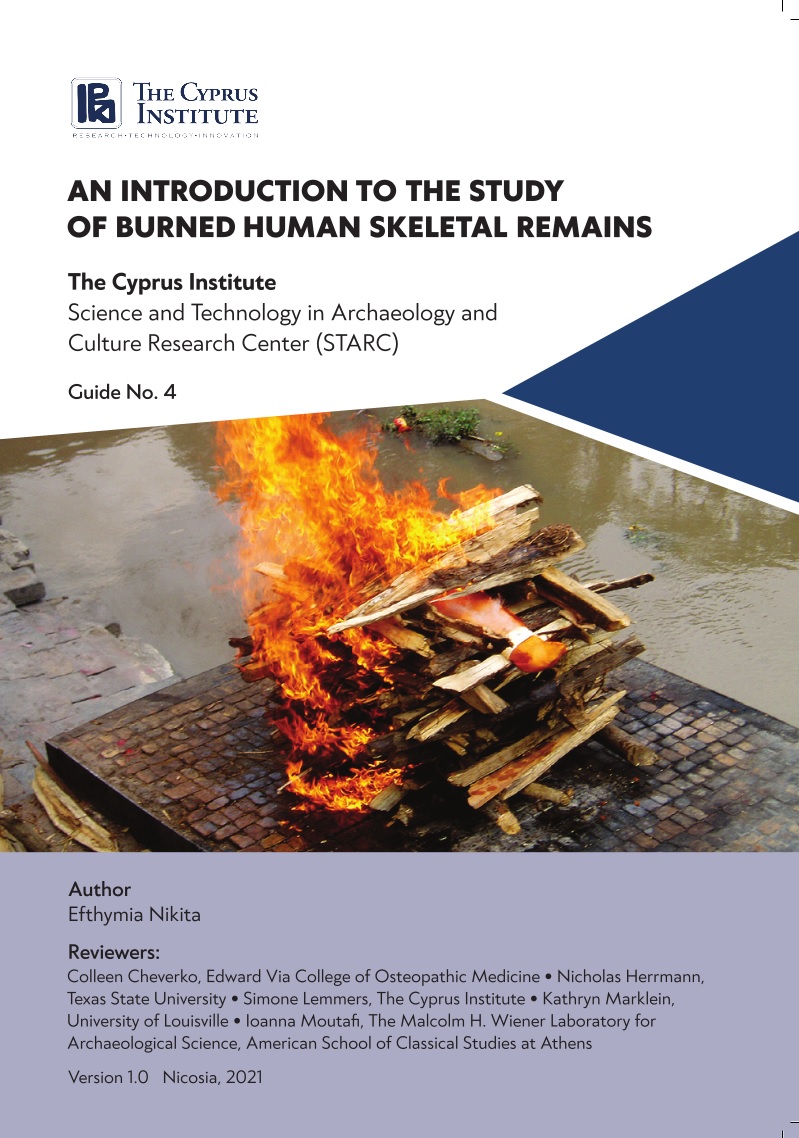 AN INTRODUCTION TO THE STUDY OF BURNED HUMAN SKELETAL REMAINS
AN INTRODUCTION TO THE STUDY OF BURNED HUMAN SKELETAL REMAINS
This document is the fourth in a series of guides aimed at promoting best practice in different aspects of archaeological science, produced by members of the Science and Technology in Archaeology and Culture Research Center (STARC) of The Cyprus Institute. The study of burned skeletal remains is particularly challenging due to the extensive alteration of the bones, manifesting as warping, discoloration, shrinkage, and fracturing. These macroscopic changes express underlying structural and chemical alterations. As a result, the application of traditional osteological methods (morphological, metric, chemical, molecular, histological and others) is largely inhibited or should be extremely cautious. Nonetheless, the study of burned skeletal assemblages can offer unique insights to funerary practices and technologies, as well as the manipulation of dead bodies. In line with the above, the aim of this guide is to cover various aspects of the study of burned skeletal assemblages. It should be seen as a supplement to the ‘Basic guidelines for the excavation and study of human skeletal remains; STARC Guide no. 1 ’ and the ‘Excavation and study of commingled human skeletal remains; STARC Guide no. 2’. This document is an open resource and it is anticipated to be updated at regular intervals. I would greatly appreciate any feedback and recommendations for future improvement.
Read more at ACADEMIA
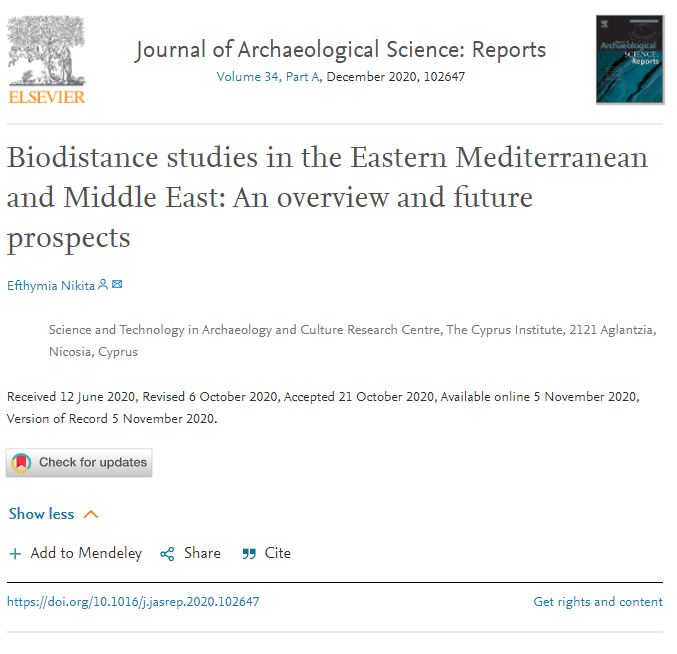 Biodistance studies in the Eastern Mediterranean and Middle East: An overview and future prospects
Biodistance studies in the Eastern Mediterranean and Middle East: An overview and future prospects
Biodistance studies have a long presence in Eastern Mediterranean and Middle Eastern (EMME) bioarchaeology. In line with trends seen in North America and elsewhere, such studies were originally typological and were often adopted to explore mass migrations, while after the advent of New Archaeology in the 1960 s, the research questions started covering issues of past population structure and short-distance mobility, and the statistical methods adopted became increasingly sophisticated. Nowadays, despite the revolution in ancient DNA and isotope studies, biodistance analyses are still broadly applied in EMME assemblages to address an ever-expanding range of topics. This paper provides a brief overview of biodistance studies in this region, with a focus on their temporal evolution. In addition, it discusses the directions in which such studies should move in the near future, with an emphasis on the need for even more studies, association of the results with other bioarchaeological, material cultural, historical and ecological information, and methodological standardization.
Read more at SCIENCE DIRECT
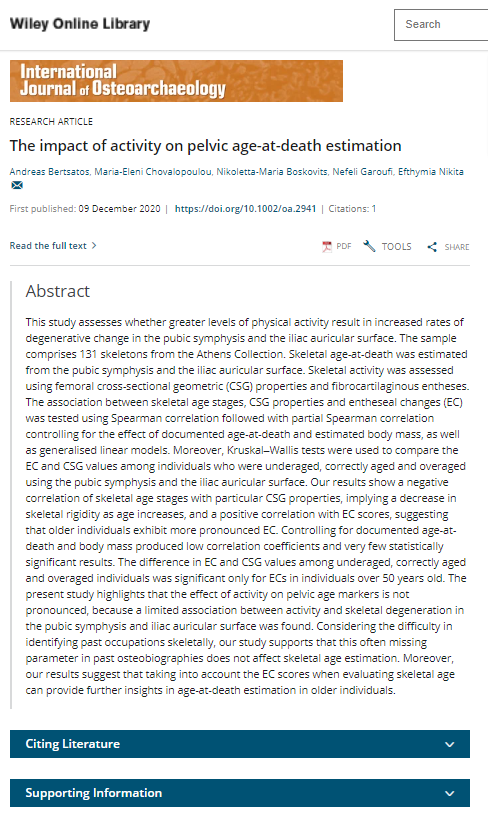 The impact of activity on pelvic age-at-death estimation
The impact of activity on pelvic age-at-death estimation
This study assesses whether greater levels of physical activity result in increased rates of degenerative change in the pubic symphysis and the iliac auricular surface. The sample comprises 131 skeletons from the Athens Collection. Skeletal age-at-death was estimated from the pubic symphysis and the iliac auricular surface. Skeletal activity was assessed using femoral cross-sectional geometric (CSG) properties and fibrocartilaginous entheses. The association between skeletal age stages, CSG properties and entheseal changes (EC) was tested using Spearman correlation followed with partial Spearman correlation controlling for the effect of documented age-at-death and estimated body mass, as well as generalised linear models. Moreover, Kruskal–Wallis tests were used to compare the EC and CSG values among individuals who were underaged, correctly aged and overaged using the pubic symphysis and the iliac auricular surface. Our results show a negative correlation of skeletal age stages with particular CSG properties, implying a decrease in skeletal rigidity as age increases, and a positive correlation with EC scores, suggesting that older individuals exhibit more pronounced EC. Controlling for documented age-at-death and body mass produced low correlation coefficients and very few statistically significant results. The difference in EC and CSG values among underaged, correctly aged and overaged individuals was significant only for ECs in individuals over 50 years old. The present study highlights that the effect of activity on pelvic age markers is not pronounced, because a limited association between activity and skeletal degeneration in the pubic symphysis and iliac auricular surface was found. Considering the difficulty in identifying past occupations skeletally, our study supports that this often missing parameter in past osteobiographies does not affect skeletal age estimation. Moreover, our results suggest that taking into account the EC scores when evaluating skeletal age can provide further insights in age-at-death estimation in older individuals.
Read more at the WILEY ONLINE LIBRARY
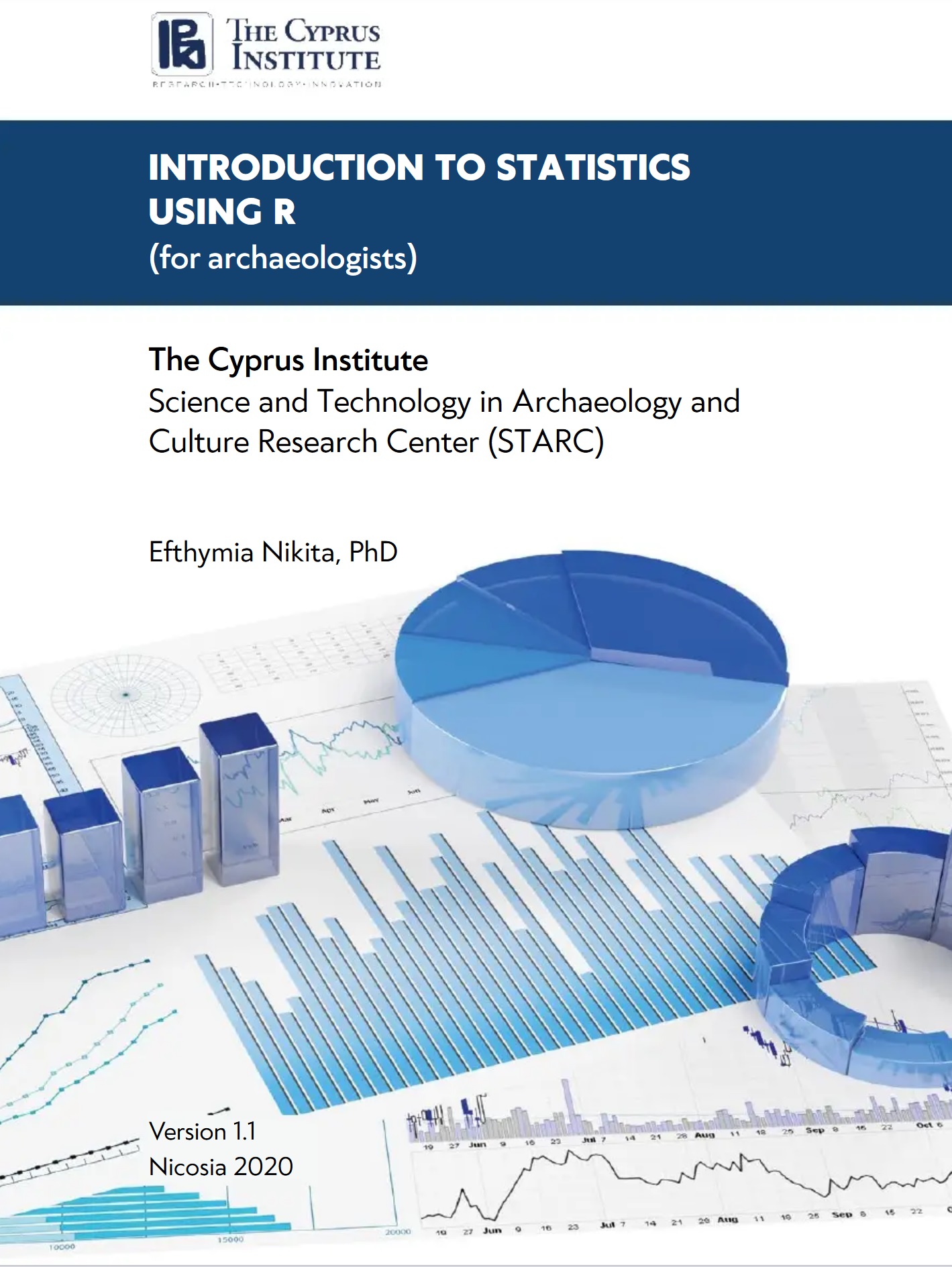 INTRODUCTION TO STATISTICS USING R
INTRODUCTION TO STATISTICS USING R
This guide covers many of the key statistical tests used in the archaeological sciences. The emphasis of the current guide is on ‘Applied Statistics’. This means that even though the mathematical principles of different statistical methods are briefly described, the key aim is to make sure the reader understands what kind of data is being analysed, what type of test is the most appropriate, how to actually implement this test correctly using R, and how to properly interpret the results. The examples given throughout this guide are taken from the archaeological sciences. However, technical terms have been intentionally avoided so that these examples are understood by non-archaeologists and it should be easy for specialists from other disciplines to see how the analyses presented could be used with their types of data and research questions. All the sample data files used in this guide are provided in the folder R_Files, which may be freely downloaded from the zenodo repository (DOI: 10.5281/zenodo.3837331). This document is an open resource and it is anticipated to be updated at regular intervals. I would greatly appreciate any feedback and recommendations for future improvement at This email address is being protected from spambots. You need JavaScript enabled to view it..
Read more at ACADEMIA
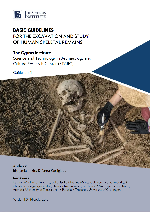 BASIC GUIDELINES FOR THE EXCAVATION AND STUDY OF HUMAN SKELETAL REMAINS
BASIC GUIDELINES FOR THE EXCAVATION AND STUDY OF HUMAN SKELETAL REMAINS
Efthymia Nikita, & Anna Karligkioti (2020)
This document is the first in a series of guides aimed at promoting best practice in different aspects of archaeological science, produced by members of the Science and Technology in Archaeology and Culture Research Centre (STARC) of The Cyprus Institute. The current document was largely developed in the context of two projects: People in Motion and Promised. This guide aims to cover the main aspects of the excavation and macroscopic study of human skeletal remains. Therefore, the current guide is meant to serve only as a general outline of best practices and the described field and lab-based methods should be modified depending on individual circumstances, such as the sample size, preservation of the material, research questions and other parameters. References are given throughout the document, but our aim is by no means to provide an exhaustive account of the literature. This document is an open resource and it is anticipated to be updated at regular intervals. We would greatly appreciate any feedback and recommendations for future improvement.
Read more at ZENODO | ACADEMIA
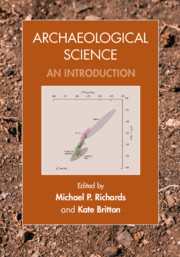 Metal. In Archaeological Science - An Introduction
Metal. In Archaeological Science - An Introduction
Thilo Rehren (2020)
Metals have always fascinated humans, for reasons ranging from practical through aesthetic to philosophical considerations. More than for other materials, this fascination can be seen to cover both the production of metals and their use. In archaeology, metals not only make a disproportionately high contribution to structuring major periods of cultural development and evolution, but archaeometallurgists specializing in the study of their production have even been referred to as a ‘priesthood’ trying to exploit secret knowledge and driving hidden agendas, potentially not in the best interest of the wider scholarly community; a charge that to the best of my knowledge has not been levelled against any other science-based discipline within archaeology, such as archaeo-botany or -zoology, or ceramic petrography. Clearly, metals fascinate humans, whether it is for the right or wrong reasons.
Read more at CAMBRIDGE UNIVERSITY PRESS
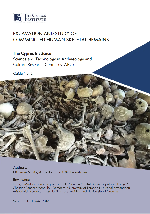 EXCAVATION AND STUDY OF COMMINGLED HUMAN SKELETAL REMAINS
EXCAVATION AND STUDY OF COMMINGLED HUMAN SKELETAL REMAINS
Efthymia Nikita, Anna Karligkioti, & Hannah Lee (2020)
This document is the second in a series of guides aimed at promoting best practice in different aspects of archaeological science, produced principally by members of the Science and Technology in Archaeology and Culture Research Center (STARC) of The Cyprus Institute. The current document was largely developed in the context of two projects: People in Motion and Promised. The current guide is meant to serve only as a general outline and the described field and lab-based methods should be modified depending on individual circumstances, such as the degree of commingling, sample size, preservation of the material, research questions and other parameters. References are given throughout the document but our aim is by no means to provide an exhaustive account of the literature. This document is an open resource and it is anticipated to be updated at regular intervals. We would greatly appreciate any feedback and recommendations for future improvement.
Read more at ZENODO | ACADEMIA
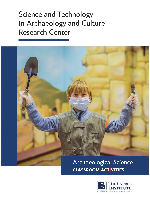 ARCHAEOLOGICAL SCIENCE CLASSROOM ACTIVITIES
ARCHAEOLOGICAL SCIENCE CLASSROOM ACTIVITIES
Efthymia Nikita, Mahmoud Mardini, Artemios Oikonomou, Giusi Sorrentino & Anna Spyrou (2020)
The activities presented focus on familiarizing students with basic methods in two broad fields: a) bioarchaeology (the study of organic remains such as human and animal bones), b) archaeological materials and material culture (ceramics, glass, metals, coins and graffiti). The proposed activities are intended for students of different age. For each activity, we provide the age range of the children to be involved; however, these ranges are only general approximations and it is up to the teacher to determine which students can participate in each activity or parts of the activity. Basic information that the teachers/instructors should communicate to the students as part of each activity is provided, along with step-by-step instructions for the implementation of each activity, and printout forms. In this way, the proposed activities can be used by any teacher, with minimal preparation and extra required materials. The implementation of most activities takes between less than one hour to two hours. A key to selected activities is given at the end of this guide. Through the proposed activities, the students are expected to develop:
-
-
-
- an understanding of the various methods available for reconstructing the human past, and
- critical thinking on how approaches from different disciplines can be used in combination to elucidate ancient lifeways.
-
-
The guide is available in both English and Greek.
Read more at ZENODO | ACADEMIA (EN) | ACADEMIA (GR) | ACADEMIA (AR)
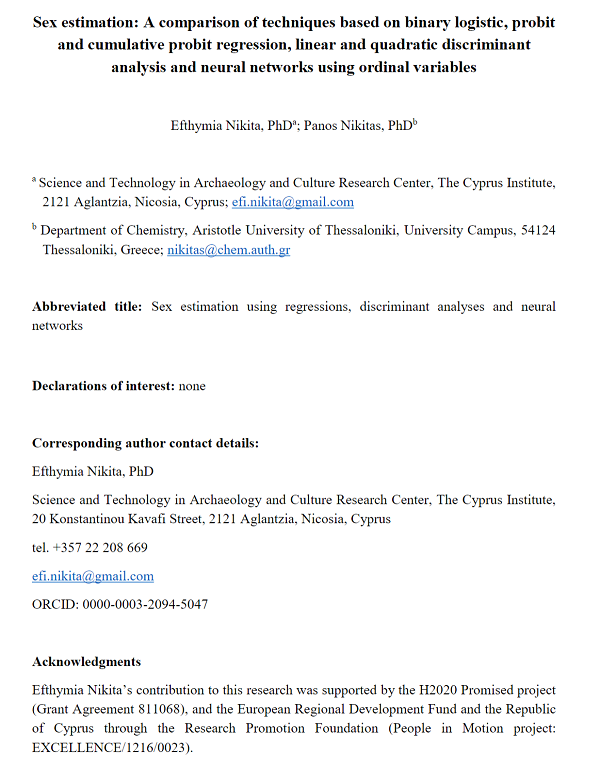 Sex estimation: A comparison of techniques based on binary logistic, probit and cumulative probit regression, linear and quadratic discriminant analysis and neural networks using ordinal variables.
Sex estimation: A comparison of techniques based on binary logistic, probit and cumulative probit regression, linear and quadratic discriminant analysis and neural networks using ordinal variables.
Efthymia Nikita, & Panos Nikitas (2020)
The performance of six classification methods, binary logistic (BLR), probit (PR) and cumulative probit (CPR) regression, linear (LDA) and quadratic (QDA) discriminant analysis, and artificial neural networks (ANN), is examined in skeletal sex estimation. These methods were tested using cranial and pelvic sexually dimorphic traits recorded on a modern documented collection, the Athens Collection. For their implementation, an R package has been written to perform cross-validated (CV) sex classification and give the discriminant function of each of the methods studied. A simple algorithm that combines two discriminant functions is also proposed. It was found that the differences in the classification performance between BLR, PR, CPR, LDA, QDA, and ANN are overall small. However, LDA is simpler and more flexible than CPR, QDA and ANN and has a small but clear advantage over BLR and PR. Consequently, LDA may be preferred in skeletal sex estimation. Finally, it is striking that the combination of pelvic and cranial traits via their discriminant functions determined either by BLR or LDA removes practically any population-specificity and yields much better predictions than the individual functions; in fact, the prediction accuracy increases above 97%.
Read more at ZENODO
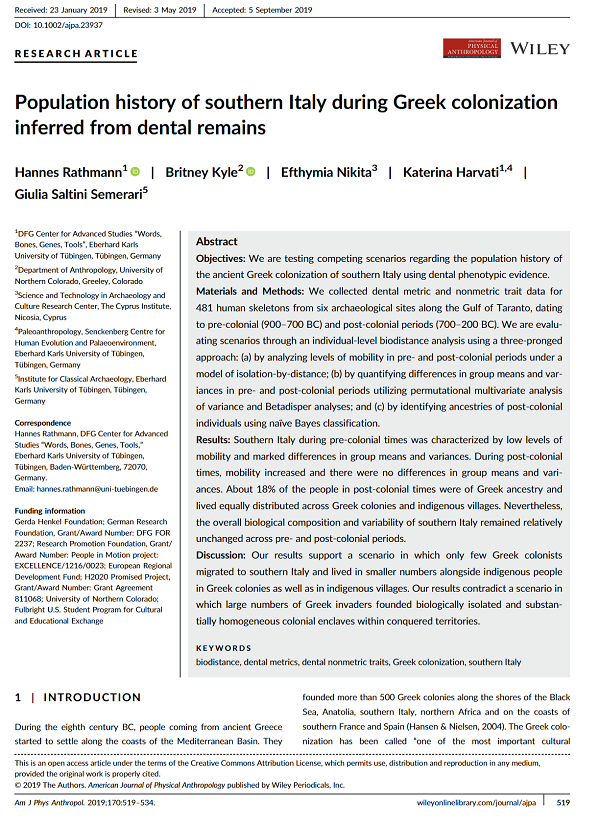 Population history of southern Italy during Greek colonization inferred from dental remains
Population history of southern Italy during Greek colonization inferred from dental remains
Hannes Rathmann, Britney Kyle, Efthymia Nikita, Katerina Harvati, & Giulia Saltini Semerari (2020)
Objectives: We are testing competing scenarios regarding the population history of the ancient Greek colonization of southern Italy using dental phenotypic evidence.Materials and Methods: We collected dental metric and nonmetric trait data for481 human skeletons from six archaeological sites along the Gulf of Taranto, dating to pre-colonial (900–700 BC) and post-colonial periods (700–200 BC). We are evaluating scenarios through an individual-level biodistance analysis using a three-pronged approach: (a) by analyzing levels of mobility in pre-and post-colonial periods under a model of isolation-by-distance; (b) by quantifying differences in group means and variances in pre-and post-colonial periods utilizing permutational multivariate analysis of variance and Betadisper analyses; and (c) by identifying ancestries of post-colonial individuals using naïve Bayes classification.
Read more at ZENODO
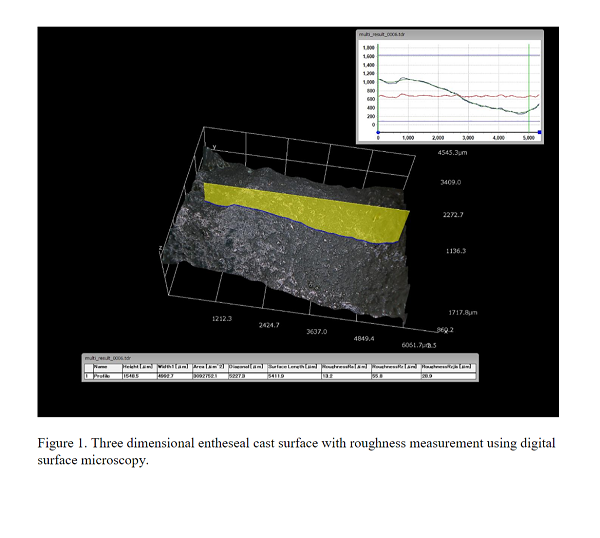 A THREE-DIMENSIONAL DIGITAL MICROSCOPIC INVESTIGATION OF ENTHESEAL CHANGES AS SKELETAL ACTIVITY MARKERS
A THREE-DIMENSIONAL DIGITAL MICROSCOPIC INVESTIGATION OF ENTHESEAL CHANGES AS SKELETAL ACTIVITY MARKERS
The current paper explores the effectiveness of entheseal changes as skeletal activity markers by testing the correlation between such changes and cross-sectional geometric (CSG) properties while controlling for the effect of age and body size. The originality of the paper lies in capturing entheseal changes in a continuous quantitative manner using 3D microscopy. Roughness and bone resorption were recorded on zone 1 and 2 of three humeral entheses (subscapularis, supraspinatus, infraspinatus) in a documented sample of 29 male skeletons. Our analysis found that merely 5.91% of the partial correlations between entheseal changes and CSG properties were statistically significant. Also, two unexpected patterns were identified, namely, a higher number of significant correlations on the left side entheses compared to the right side ones and a higher number of correlations between minimum roughness and CSG properties compared to mean and maximum roughness. These patterns are the inverse of that we would expect if the activity had exerted an important effect on entheseal change expression. Therefore, they support the lack of association between entheseal changes and habitual activity, even though various factors potentially affecting the above results are discussed.
Read more at ZENODO
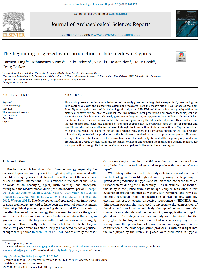 The beginning of glazed ware production in late medieval Cyprus
The beginning of glazed ware production in late medieval Cyprus
Carmen Ting, Athanasios Vionis, Thilo Rehren, Vasiliki Kassianidou, Holly Cook, Craig Barker (2019)
This study presents the first characterisation of the early glaze technology that emerged in Cyprus during the 13th century CE, with the glazed ware assemblage recovered from the theatre site at Nea Paphos as the main focus. By framing the results of the technological study using SEM-EDS and thin-section petrography within the historical context, we can establish the link between local production and broader technological and socio-historical developments. The early glaze technology in Cyprus appears to have followed the established traditions characteristic of the eastern Mediterranean region during the late medieval period. This is reflected in the use of high lead glaze, the addition of iron and copper oxide as colourants, and the use of painting and sgraffito as principal decorative techniques. Although the introduction of glaze production in Cyprus coincided with the time when the island fell under the Frankish rule, there is no evidence indicating that the Frankish rulers directly controlled the production or the Franks were involved in the actual production process. However, we argue that the establishment of the Frankish influence had indirectly stimulated the beginning of glazed ware production in Cyprus by facilitating the movement of labour and creating the market and demand required for such production through its link to the Crusaders' campaigns in the wider Levantine region.
Read More at SCIENCE DIRECT



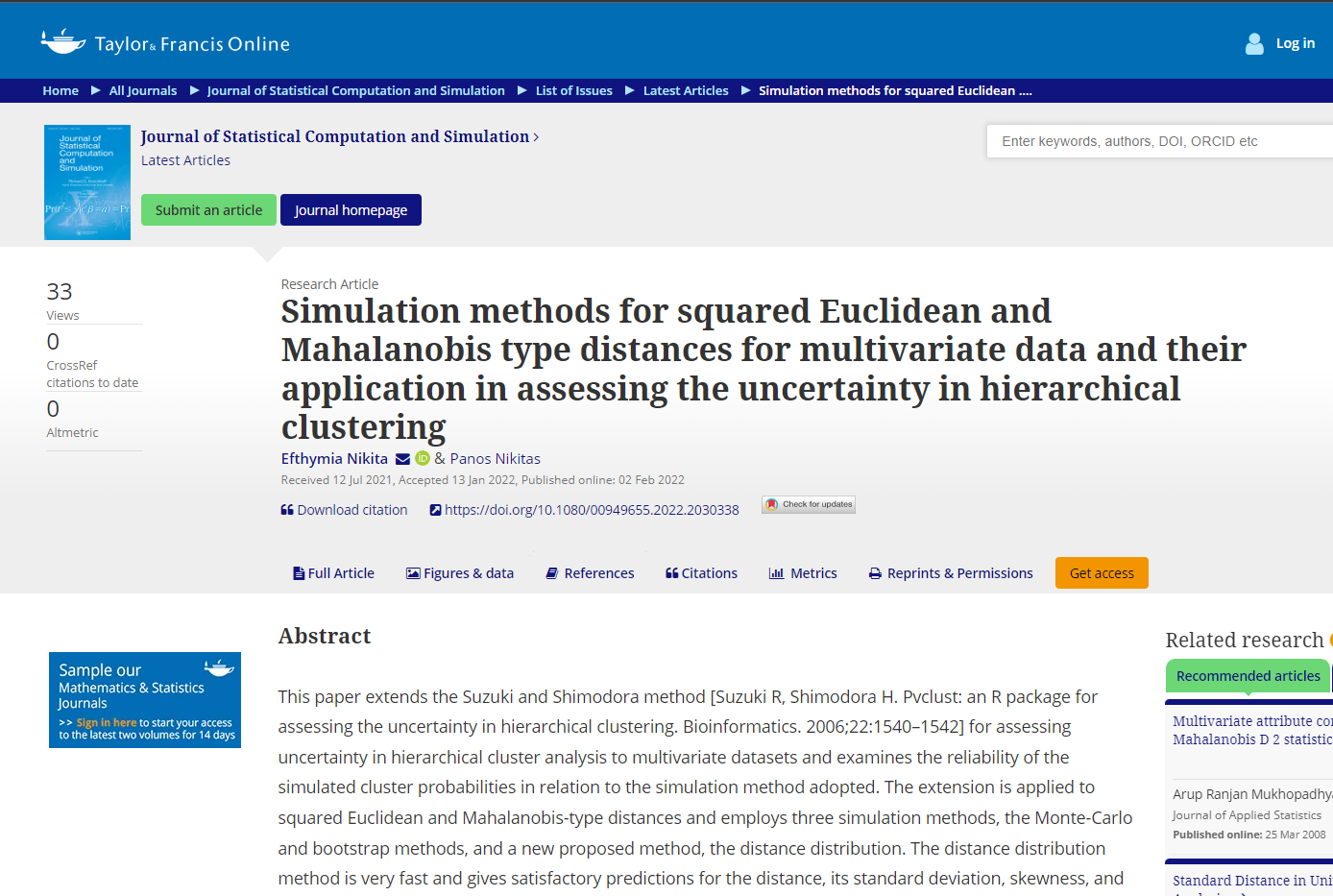 Simulation methods for squared Euclidean and Mahalanobis type distances for multivariate data and their application in assessing the uncertainty in hierarchical clustering
Simulation methods for squared Euclidean and Mahalanobis type distances for multivariate data and their application in assessing the uncertainty in hierarchical clustering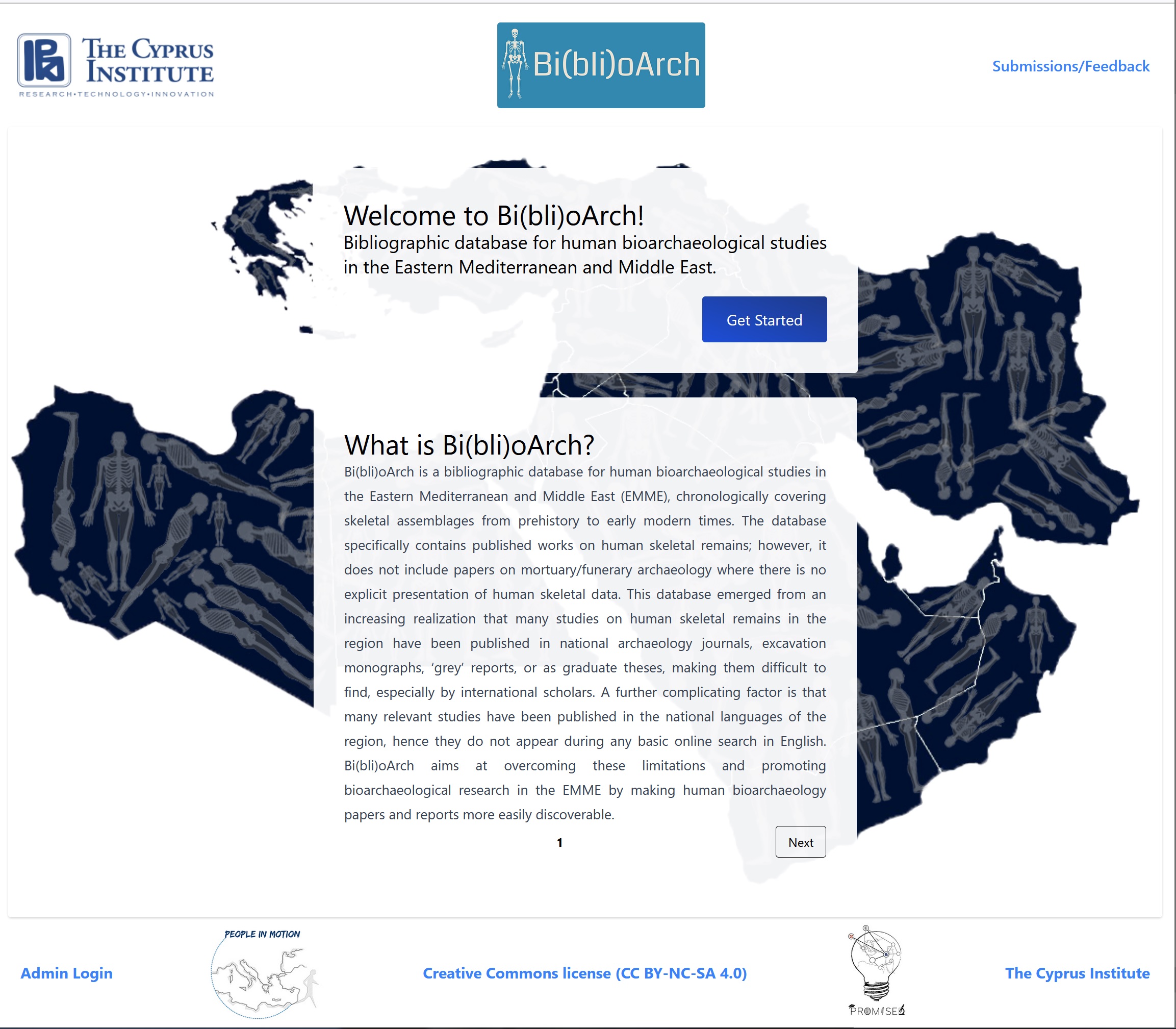 Bi(bli)oArch: An open-access bibliographic database for human bioarchaeological studies in the Eastern Mediterranean and Middle East
Bi(bli)oArch: An open-access bibliographic database for human bioarchaeological studies in the Eastern Mediterranean and Middle East